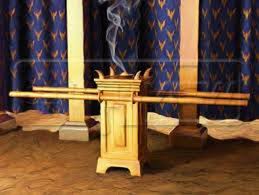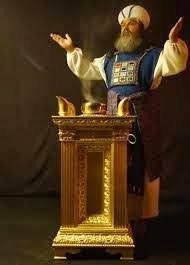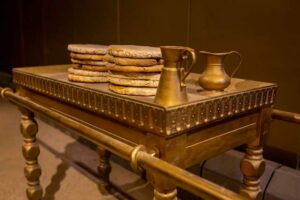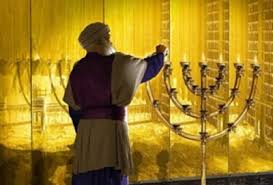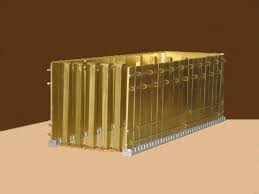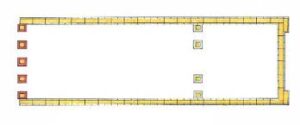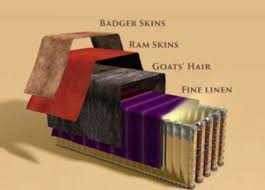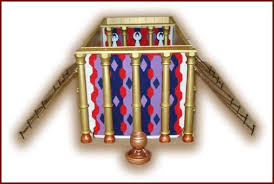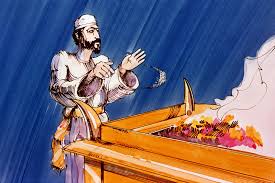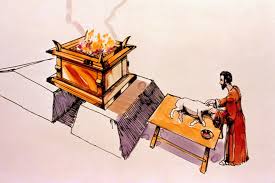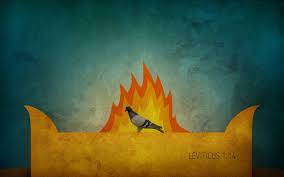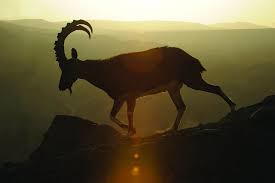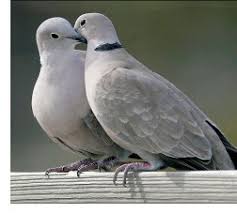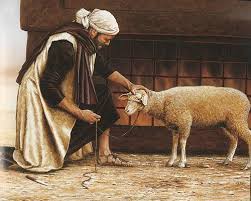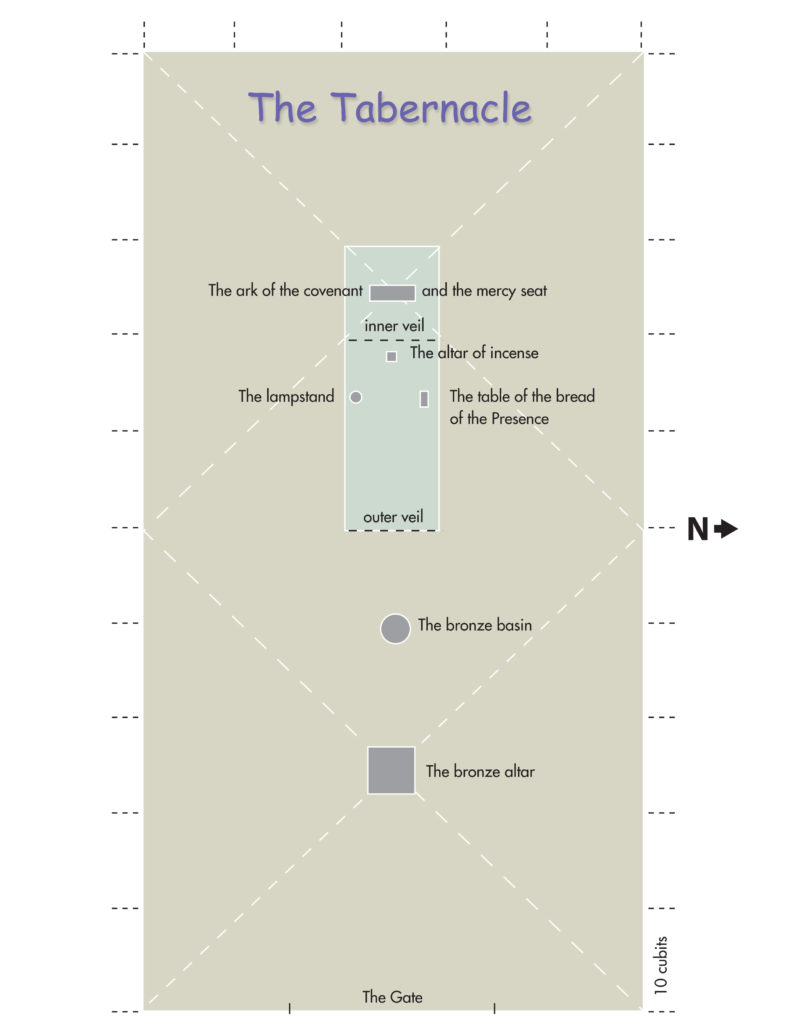Fs – The Mercy Seat: Christ at the Throne of Grace 25:17-22 and 37:6-9
The Mercy Seat in the Most Holy Place:
Christ at the Throne of Grace
25:17-22 and 37:6-9
The mercy seat in the Most Holy Place: Christ at the throne of grace DIG: Since idols were prohibited, why were the cherubim on the Ark’s cover? Where else were they displayed in the Sanctuary? What was their purpose? How were the cherubim in the Garden connected to the cherubim in the Sanctuary?
REFLECT: How is Christ your Mercy Seat? How has He been merciful to you? Has He covered your sins with His blood? Why is it good news for you that the mercy seat was the only seat in the Tabernacle?
There were seven pieces of furniture in the Tabernacle, and the Mercy Seat would be the final piece. The Most Holy Place was a type of heaven itself. The high priest who ministered there foreshadowed Christ, our Great High Priest, before the throne of grace. All was glory and beauty there. As he entered he looked around him and saw the white curtains with their gold frames. He looked above him and saw the beautiful figures of the cherubim embroidered in blue, purple and scarlet upon the fine twisted linen. Last, but not least, he saw the Sh’khinah glory between the cherubim of gold that formed the Mercy Seat.
The Ark with its Mercy Seat was clearly the most important object in the Sanctuary. It was the focal point of attention, especially on the Day of Atonement when the sacrificial blood was sprinkled on that seat. The word for Mercy Seat comes from the Hebrew root meaning, to cover, and thus illustrates an important aspect of Divine mercy.609 The Mercy Seat was made of pure gold – three feet, nine inches long, two feet, three inches wide and high. Although it was a separate piece of furniture, it functioned as a movable cover on top of the Ark itself. Its thickness is not mentioned. Two cherubim of hammered gold were made of one piece with the Mercy Seat. They faced each other from opposite ends, looking down with their wings spread upward, overshadowing the space between them (25:17-21, 37:6-9). This points to the eternal truth that God’s mercy cannot be separated from His holiness. That is why the Psalmist would say, as he looked forward to the cross: Mercy and truth have met together; while righteousness and peace have kissed each other (Psalm 85:10).610
There are orders, or ranks of celestial beings. The angels are the lowest order, with Michael being the chief, or archangel. Above them are the seraphs, or seraphim. But above them, or the highest order of celestial beings, are the cherubs, or cherubim. Cherubs have two wings, seraphs have six wings, and angels have no wings whatsoever. No description of the cherubim are given here; however, the details are provided in Ezeki’el 1:4-21, 10:1-22; Revelation 4:6-9. The Sh’khinah glory is never associated with angels, or seraphs. It is only associated with the highest order, the cherubim. They were also woven into the curtain that covered the Sanctuary (26:1-6), and into the inner veil (26:31-33).
The purpose of cherubs over the Mercy Seat was to symbolize the throne of God. They protected and guarded the way into His Presence. They guarded the way to the tree of life in the Garden of Eden with a flaming sword flashing back and forth (Genesis 3:24). It was mercy, as well as judgment, that drove man out of the Garden, let us not forget that! Since any image of God was strictly forbidden, the best Isra’el could do was to make an image of those beings closest to Him.611 He is referred to as the One who is enthroned between the cherubim (Numbers 10:35-36; First Samuel 4:4, 6:20; Psalm 80:1-3, 99:1). There we can approach the throne of grace with confidence, so that we may receive mercy and find grace to help us in our time of need (Hebrews 4:16).
It was the only seat in the Tabernacle. There were no chairs for the priests. Their work was never done. They continued to stand day after day, performing their religious duties, again and again offering the same sacrifices, which could never take away sins (Hebrews 10:11). The only seat in the Tabernacle was God’s throne, where mercy reigned. It reigned because He planned it that way from all eternity past, to offer Himself as the perfect Sacrifice for sin once for all (Hebrews 7:27). When the time came, He let wicked men crucify Him on the cross. Having paid the penalty for sin, He cried out in triumph: It is finished (John 19:30). Then He gave up His Spirit to the Father. Three days and three nights He lay in Joseph of Arimathea’s new tomb. Then He rose, victorious over death and the grave. For forty days He showed Himself alive to those who loved Him, convincing His disciples that He would live forever. He ascended into heaven and sat down at the right hand of God (Hebrews 10:12). His work of redemption was completed; therefore, He sat down to wait until His enemies become His footstool (Psalm 110:1).612
In the Scriptures, our first glimpse of the cherubim was when they guarded the way to the tree of life in the Garden of Eden with a flaming sword (Genesis 3:24). Man had sinned. God, in judgment, had to drive him out of Eden. If Adam had eaten of the tree of life while in a fallen state, he would live forever with no chance of forgiveness for his sins. Every avenue to the original, happy state that Adam had enjoyed was closed. Satan could not be allowed back to the tree of life either. It had to be protected. So the cherubim took their stand as the avengers of God’s holiness. And as for mankind, humanly speaking, there was no way back to the tree of life. The cherubim guarding the Garden pointed to the hopelessness of any attempt on the part of man to regain eternal life by his own efforts. Unless the holiness of God was satisfied, man would wander in vain for his salvation.
The cherubim of the Most Holy Place teach us the same lesson. They guarded the way until the veil was torn in two from top to bottom (Matthew 27:51). The Torah within the Ark demanded the death of the offender; but above the Torah were the cherubim, no longer barring man’s approach to life, but with outstretched wings above the place of mercy. And the blood upon the Mercy Seat satisfied the holiness of God. That is why the cherubim were no longer connected with the flaming sword. Their faces were turned toward the Mercy Seat, looking down upon the blood that foreshadowed the death of the Substitute who was to come.
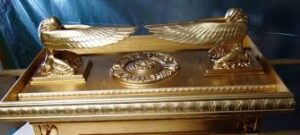
God met with His people above the mercy seat between the two cherubim on the Day of Atonement (to see link click Go – The Day of Atonement). There, the high priest sprinkled the blood of the sacrifice. It was the blood that made it a mercy seat. But Aaron was only able to go into the Most Holy Place after he had offered the sacrifice upon the bronze altar. Likewise, without the shed blood of the Son of God, there could be no communication, no fellowship, between God and His sinning people. But Christ entered the Most Holy Place once for all by His own blood, having obtained eternal redemption (Hebrews 9:12).613
The Mercy Seat was the place of propitiation. The word propitiation means to satisfy. And it was at the Mercy Seat that God’s wrath against sin was atoned for, or satisfied. At that time, He was able to show us His mercy by not giving us what we deserve. On the Day of Atonement, the high priest would sprinkle the blood of a goat over the Mercy Seat, when this was done God’s wrath against sin for the nation was satisfied. Today, Christ is our Mercy Seat. Believing in who He is and what He did on the cross satisfies ADONAI’s wrath toward sinners. When Christ died for our sins, He satisfied every claim of God’s holiness and justice, so that ADONAI is free to act on behalf of sinners.
This is the Good News: For God so loved the world that He gave His one and only Son, that whoever believes in Him shall not perish, but have eternal life (John 3:16).





